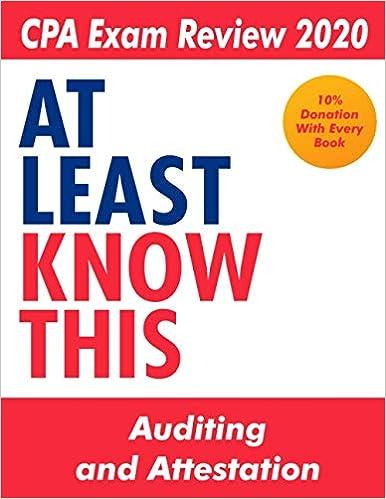Question
1) Indiana Company incurred the following costs during the past year when planned production and actual production each totaled 20,000 units: a. Direct material used
1) Indiana Company incurred the following costs during the past year when planned production and actual production each totaled 20,000 units:
a. Direct material used $280,000
b. Direct labor $120,000
c. Variable manufacturing overhead $160,000
d. Fixed manufacturing overhead $100,000
e. Variable selling and administrative costs $60,000
f. Fixed selling and administrative costs $90,000 g. If Indiana uses variable costing, the total inventorial costs for the year would be:
h. $400,000.
i. $460,000
j. $560,000.
k. $620,000.
l. $660,000.
7) Martina, Inc. has two service departments (Human Resources and Building Maintenance) and two production departments (Machining and Assembly). The company allocates Building Maintenance cost on the basis of square footage and believes that Building Maintenance provides more service than Human Resources. The square footage occupied by each department follows. Human Resources 6,000 Building Maintenance 13,000 Machining 18,000 Assembly 26,000 Assuming use of the direct method, over how many square feet would the Building Maintenance cost be allocated (i.e., spread)?
a. 19,000.
b. 44,000.
c. 50,000.
d. 63,000.
8) Consider the following comments about absorption- and variable-costing income statements:
I. A variable-costing income statement discloses a firms contribution margin.
II. Cost of goods sold on an absorption-costing income statement includes fixed costs.
III. The amount of variable selling and administrative cost is the same on absorption- and variable-costing income statements.
Which of the above statements is (are) true?
b. I only.
c. II only.
d. I and II.
e. II and III.
f. I, II, and III.
11) Lone Star has computed the following unit costs for the year just ended: Direct material used $12 Direct labor $18 Variable manufacturing overhead $25 Fixed manufacturing overhead $29 Variable selling and administrative cost $10 Fixed selling and administrative cost $17 Under variable costing, each unit of the companys inventory would be carried at:
a. $35.
b. $55.
c. $65.
d. $84.
e. some other amount.
12) Rocky Mountain Company produces two products (X and Y) from a joint process. Each product may be sold at the split-off point or processed further. Additional processing requires no special facilities, and production costs of further processing are entirely variable and traceable to the products involved. Joint manufacturing costs for the year were $60,000. Sales values and costs were as follows: I. If Processed Further Product Units Made Sales Value at Split-Off Sales Value Separable Costs X 9,000 $40,000 $78,000 $10,500 Y 6,000 80,000 90,000 7,500 If the joint production costs are allocated based on the physical-units method, the amount of joint cost assigned to product X would be:
a. $20,000.
b. $24,000.
c. $30,000.
d. $36,000.
e. $40,000.
14) Lone Star has computed the following unit costs for the year just ended: Direct material used $12 Direct labor $18 Variable manufacturing overhead $25 Fixed manufacturing overhead $29 Variable selling and administrative cost $10 Fixed selling and administrative cost $17 Under absorption costing, each unit of the companys inventory would be carried at:
a. $65.
b. $84.
c. some other amount.
d, $55.
e. $35.
16) Martina, Inc. has two service departments (Human Resources and Building Maintenance) and two production departments (Machining and Assembly). The company allocates Building Maintenance cost on the basis of square footage and believes that Building Maintenance provides more service than Human Resources. The square footage occupied by each department follows. Human Resources 6,000 Building Maintenance 13,000 Machining 18,000 Assembly 26,000 Assuming use of the step-down method, over how many square feet would the Building Maintenance cost be allocated (i.e., spread)?
a. 19,000.
b. 44,000.
c. 50,000.
d. 63,000
e. More information is needed to judge.
17) Which of the following situations would cause variable-costing income to be lower than absorption-costing income?
a. Units sold equaled 39,000 and units produced equaled 42,000.
b. Sales prices decreased by $7 per unit during the accounting period.
c. Selling expenses increased by 10% during the accounting period.
d. Units sold equaled 55,000 and units produced equaled 49,000.
e. Units sold and units produced were both 42,000.
18) Indiana Company incurred the following costs during the past year when planned production and actual production each totaled 20,000 units: . Direct material used $280,000 . Direct labor $120,000 . Variable manufacturing overhead $160,000 . Fixed manufacturing overhead $100,000 . Variable selling and administrative costs $60,000 . Fixed selling and administrative costs $90,000 Indianas per-unit inventoriable cost under variable costing is:
a. $9.50.
b. $25.00.
c. $28.00.
d. $33.00.
e. $40.50.
Step by Step Solution
There are 3 Steps involved in it
Step: 1

Get Instant Access to Expert-Tailored Solutions
See step-by-step solutions with expert insights and AI powered tools for academic success
Step: 2

Step: 3

Ace Your Homework with AI
Get the answers you need in no time with our AI-driven, step-by-step assistance
Get Started


